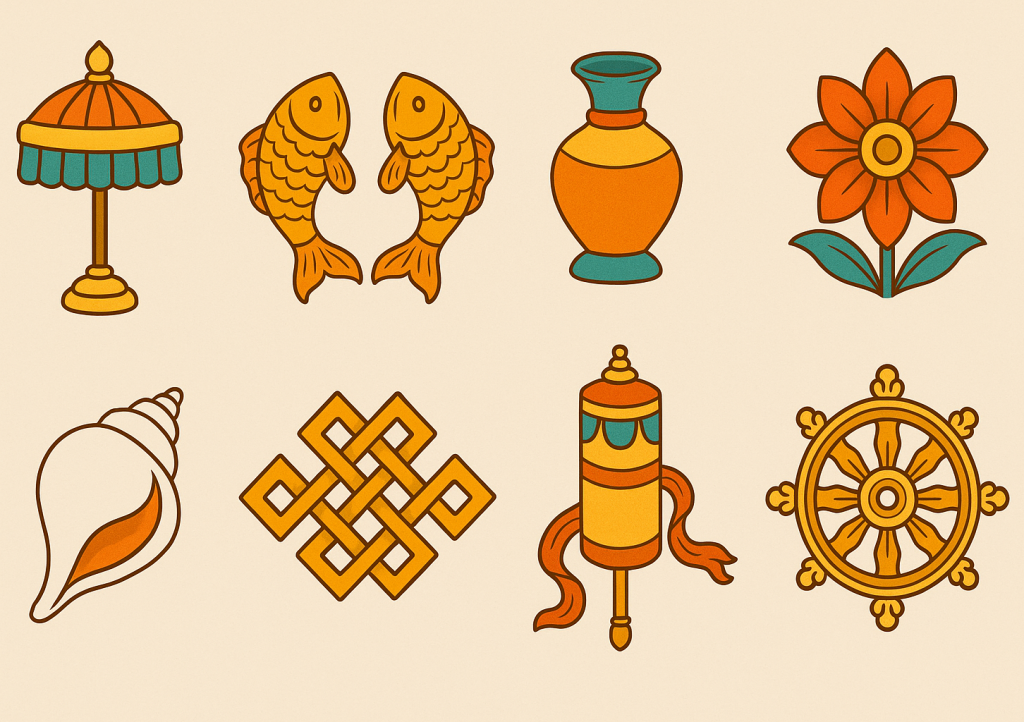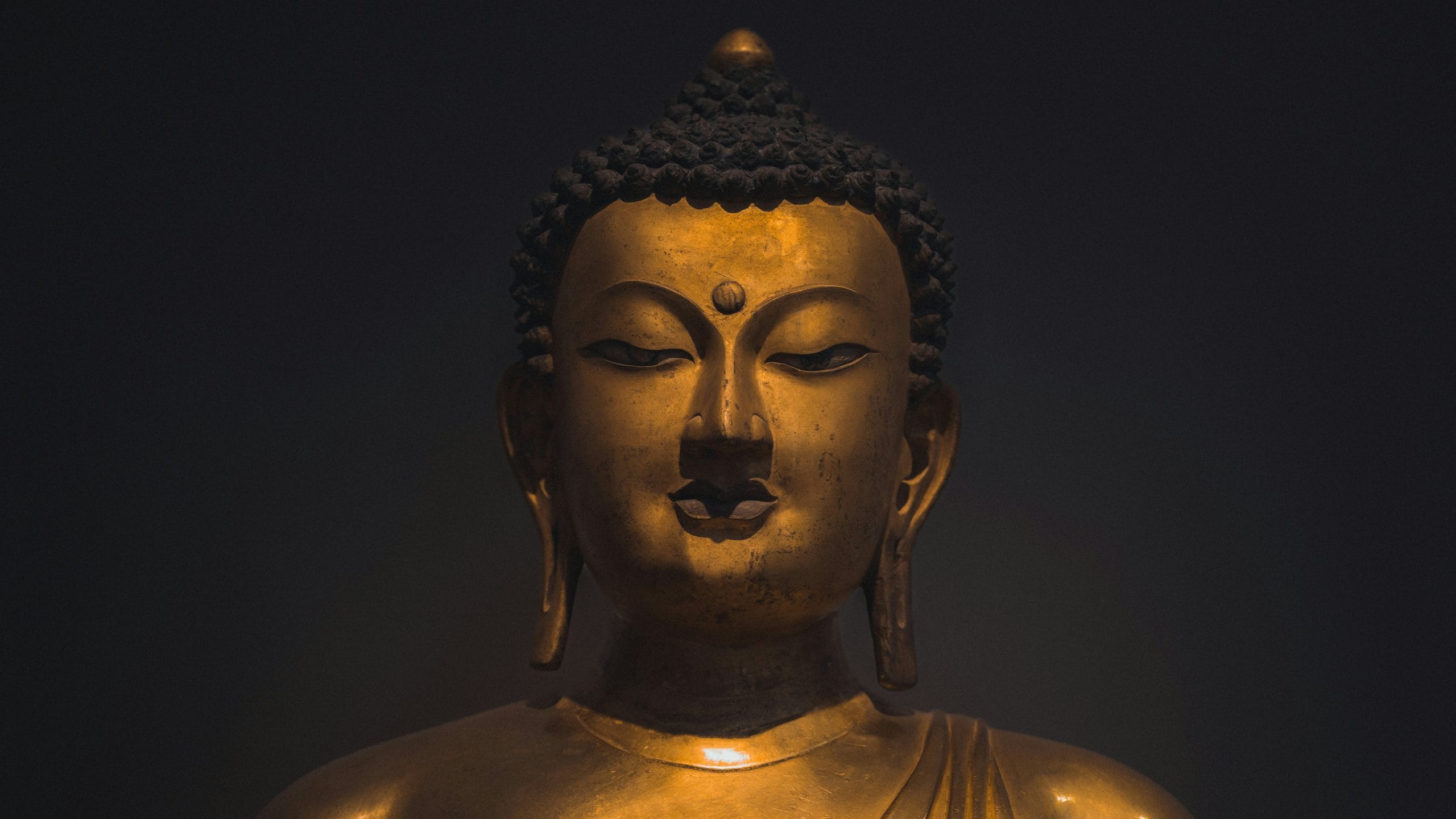In the immense spiritual legacy of Asia, few traditions have developed such a rich symbolic language as the Buddhism.
The 8 Buddhist symbols -also known as Ashtamangala- are not simple ornamental images: they are living teachings, concentrated in sacred forms.
These sacred Buddhist symbols appear in temples, manuscripts, sculptures, thangkas, rituals and even personal objects, as a constant invitation to reconnect with the deepest truth.
In this article I invite you to discover the origin, meaning and spiritual power of the the buddhist 8 symbolsand how they can inspire you in your daily life.
What are the Buddhist symbols?
"Ashtamangala" is a Sanskrit word composed of. ashta (eight) and mangala (auspicious).
These eight Buddhist symbols represent fundamental values of the path to enlightenment: compassion, wisdom, protection, purity, interdependence, abundance, freedom and truth.

They are present in Tibetan and Nepalese art and even in the offerings made during important ceremonies. They are considered sacred Buddhist symbols that protect, guide and inspire.
Each of the buddhist 8 symbols contains a universal teaching:
The divine origin of the sacred Buddhist symbols
The story goes that upon attaining enlightenment, Shakyamuni Buddha received divine offerings from celestial beings. Among them were these eight sacred symbols, which have since become emblems of awakening.
From the white conch that announces the Dharma, until the Dharma wheel that sets it in motion, each symbol has its own voice and message.
Thus were born the buddhist 8 symbolsused today in rituals, art, meditation, architecture and spiritual design.
- Brahma gave him the Dharma Wheel.
- Indra presented a White Conch.
- The Earth Goddess offered a Treasure Vase.
- The King of the Nagas deployed a Precious Parasol.
- Laksmi presented him with the Infinity Knot.
- Shiva placed before him the Victory Banner.
- The GOLDFISH and lotus completed this symbolic offering.
Since then, these Buddhist symbols remind us of the real possibility of our own enlightenment.
The spiritual Buddhist symbols and their meanings
Each of these sacred Buddhist symbols is a silent master. Let's see what each of them whispers to the soul:
1. The Precious Parasol (Chatra)
Symbolizes the spiritual protection in the face of ignorance, desire and suffering. It is the refuge of the Dharma that shelters those who seek the truth.
2. The Golden Fish Couple (Suvarna-Matsya)
Swimming freely and happily, the fish represent the liberation from the ocean of samsara. They remind us that we can flow joyfully through life, without fear.
3. The Treasure Vase (Kalasha)
An inexhaustible source of spiritual and material abundance. It teaches us that true wealth does not run out, because it is born from an awakened heart. An emblem of inexhaustible abundance and long life. It reminds us that true wealth is in wisdom and compassion.
4. The Lotus Flower (Padma)
Pure, luminous, born from the mud without staining. The lotus represents the possibility to emerge impeccable from any situation, reborn into the light. From the mud it emerges pure and beautiful. The lotus symbolizes the purity of heart and spiritual awakeningbeyond suffering.
5. The White Conch (Shankha)
Its sound resounds like the call of the Dharma, inviting us to awakening from the sleep of ignorance and to walking towards eternal wisdom.
6. The Endless Knot (Shrivatsa)
Intricate and timeless, the knot expresses the interconnection of all things. Nothing exists in isolation; everything is woven into the infinite web of life.
7. The Banner of Victory (Dhvaja)
It represents the triumph of the Buddha over the dark forces. It reminds us that inner victory is possible when we cultivate love, wisdom and equanimity.
8. The Wheel of Dharma (Dharmachakra)
It symbolizes the complete path to awakening: ethics, concentration and wisdom. It rotates eternally, carrying the Dharma to all corners.
The Buddhist 8 symbols as a guide in your life
Behold the buddhist 8 symbols is not only a devotional or aesthetic act. It is an inner practice, a tool to transform the mind.
Each of these sacred Buddhist symbols can become a mirror: they show you where you are and where you can go.
You can carry them with you in personal objects, meditate on them, draw them or simply let them into your life.
Its energy accompanies you. His presence reminds you of what is essential.
Live the message of the 8 symbols of Buddhism
In a world saturated with distractions, the symbols of Buddhism back to the center.
They invite us to reconnect with the sacred, with the simple, with what really matters.
Contemplating them is like reading a sutra in silence: a teaching that rests directly on the heart.
If you feel this path is calling you, an excellent way to begin is to delve deeper into the core teachings.
I recommend the book Buddhism for Beginners, a clear, friendly and accessible guide that explains in a simple way the fundamental principles of Buddhism, ideal if you are taking your first steps or want to reconnect with what is essential.
What if today you were to choose one of the buddhist 8 symbols to meditate with him for seven days?
Watch it. Listen to it. Let yourself be touched by its message.
Because sometimes, a sacred image can change the direction of an entire path.
And a book, a practice or a symbol can be just the beacon your soul has been waiting for.


Leave a Reply